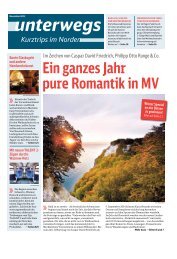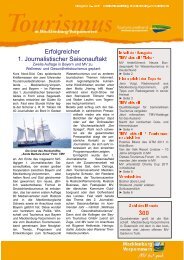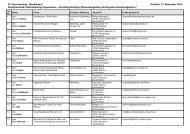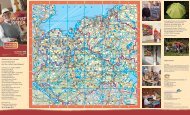Tagungsort Grand Hotel Heiligendamm
Tagungsort Grand Hotel Heiligendamm
Tagungsort Grand Hotel Heiligendamm
Erfolgreiche ePaper selbst erstellen
Machen Sie aus Ihren PDF Publikationen ein blätterbares Flipbook mit unserer einzigartigen Google optimierten e-Paper Software.
on the coast of California and this image is of<br />
a pier across the bay from San Francisco. And<br />
of course there are some delightful East Sea<br />
piers. One of the great strengths of piers is<br />
that architecturally and in engineering terms,<br />
they vary so much.<br />
Sometimes seaside architecture as an extreme<br />
will include invented forms of architecture.<br />
This is the pier in Nice, France, demolished in<br />
the 1940s, and designed as an exotic ‘Oriental’<br />
structure suggesting other parts of the world.<br />
In Britain, the USA and in France, one of the<br />
really strong motifs or architectural ideas is<br />
ornamental or Oriental architecture. This is<br />
the 1820s Royal Pavilion in Brighton, which<br />
started the interest in Orientalism at the seaside<br />
and was endlessly copied. It is an invented<br />
Eastern style combining elements of Indian,<br />
Oriental and Chinese architecture.<br />
Another theme in seaside architecture has<br />
been to use ideas of exotic other locations and<br />
vegetation to make places seem to be somewhere<br />
else and extraordinary different. Here<br />
is a 1950s poster for the Cote de Azure with<br />
architecture, with palm trees, sun and bikinis.<br />
And this is a British version of the same thing.<br />
And a cast iron palm tree on Coney Island in<br />
New York City. The palm tree is one of those<br />
ideas that you see endlessly repeated in northern<br />
seaside places.<br />
So, in summary, I would argue we need a<br />
<br />
seaside architecture. I now want to turn to my<br />
second theme, history, culture and nature.<br />
This is an early picture of Scarborough, one<br />
of the very early sea bathing places in Britain,<br />
showing sea bathing taking place and early<br />
bathing machines. And of course the nature<br />
of the people who went to the seaside was<br />
very limited. It was a very high class, leisured,<br />
wealthy group of people using the seaside.<br />
That was the 18th century. By the mid-19th<br />
century a broader range of people were starting<br />
to visit the seaside. This is Ramsgate on<br />
the southeast coast of England. Ramsgate<br />
Sands in the mid-19th century with a railway<br />
station and a steam engine bringing people to<br />
the seaside. People dressed not for the seaside<br />
so much as for city life. And the West Pier in<br />
Brighton on the south coast of England; again<br />
<br />
piers. By the end of the 19th century, though,<br />
that changes in Britain. Architecture is increasingly<br />
used by a much broader mass of people.<br />
This is Blackpool showing the North Pier and<br />
its oriental architecture and then in the distance<br />
the Blackpool Big Wheel and Tower. So<br />
this is an architecture made of iron, glass and<br />
wood for mass tourism. Class has changed at<br />
the seaside. I think one of the challenges now<br />
is how do seaside resorts target particular segments<br />
of the population. Is the objective to<br />
have a broad range of people coming to the<br />
<br />
range? Apart from class, I think gender has<br />
been a really important dimension of the seaside<br />
and its architecture. This image is Margate,<br />
southeast coast of England. A very early print<br />
of, what in Britain we would describe using the<br />
expression “dirty old men”, leering at naked<br />
bathers. And that obsession with gender at the<br />
seaside and how the seaside is portrayed has<br />
continually evolved and developed. Publicity<br />
for Margate from the interwar years and if you<br />
count the number of young women and the<br />
number of men, there is a disparity between<br />
the two. There are many more young women<br />
in this publicity poster than there are men.<br />
24
















